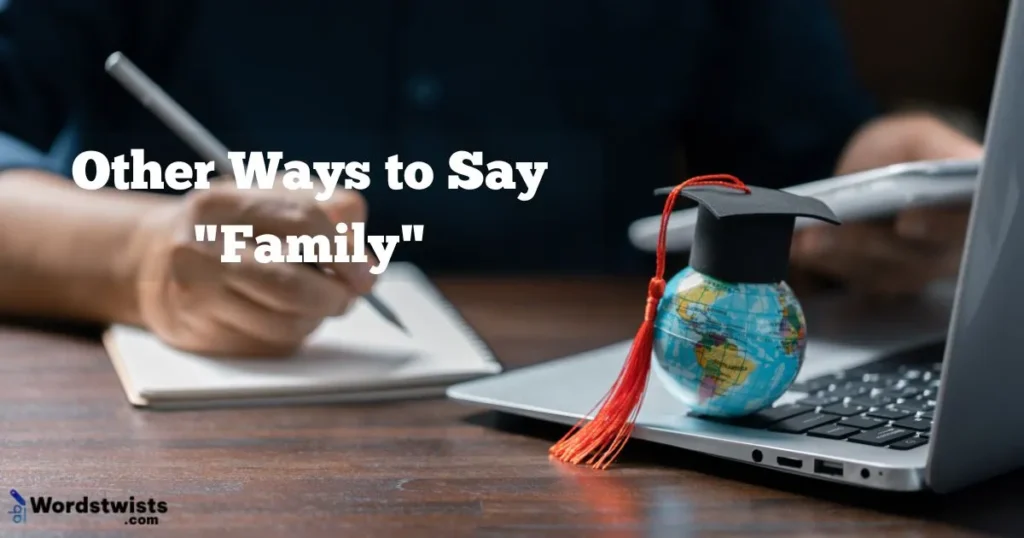Hey there! If you’ve ever found yourself stuck using the same old phrase “Other Ways to Say Family” again and again, you’re definitely not alone. It can get frustrating when you want to sound fresh, thoughtful, or simply more precise in your writing, speaking, or storytelling. Maybe you’re crafting a heartfelt speech for a wedding, writing a touching greeting card, or just trying to spice up your personal blog or social media post — either way, relying on the same words over and over feels limiting.
That’s why I put together this list of 25 compelling alternatives to “family” that will help you add more style, personality, and clarity to your communication. Using these alternatives not only makes your language more vibrant but also helps your compliments, descriptions, or stories truly stand out. Whether you want a formal tone for a business presentation, a warm and casual vibe for a friendly conversation, or a poetic touch for a literary piece, there’s something here for every situation.
These synonyms and related terms encompass a variety of people — from immediate family members like parents, siblings, and children, to extended relatives such as cousins, aunts, and grandparents. You’ll also find words connected to broader concepts like household, clan,crew, and community, reflecting diverse cultures and social groups around the world. Plus, some terms highlight the emotional and physical spaces tied to family, such as home, hearth, and kinship network.
Ready to upgrade your vocabulary and connect better with your audience? Dive in and explore these fresh, meaningful ways to say family — your writing, speech, and relationships will thank you!
25 Alternatives to “Family”
1. Household
Explanation:
The word household refers to the people who live together in the same home. It’s a practical way to describe a family unit without always saying “family.” This term is often used in official or formal contexts but can also feel personal when describing daily life.
Usage examples:
- Our household includes my parents, my sister, and me.
- The entire household gathered for the holiday dinner.
- She manages all the chores around the household efficiently.
- Census data often counts the number of people per household.
- Our household pets are considered part of the family too.
Why it works:
It highlights the shared living situation and creates a clear, practical image of the family members as part of a single unit.
2. Clan
Explanation:
A clan is a group of people united by strong family ties or common ancestors. It carries a sense of tradition, history, and loyalty — often used when emphasizing deeper roots or heritage.
Usage examples:
- The Scottish clan system has been around for centuries.
- Our clan reunites every summer to celebrate our heritage.
- He proudly wears his clan tartan at special events.
- The warrior clan defended their land fiercely.
- She traces her lineage back to a famous clan chief.
Why it works:
It connects family with legacy and cultural identity, adding depth and respect to your description.
3. Kin
Explanation:
Kin means relatives or people related by blood or marriage. It’s a simple yet formal way to refer to family members, often used in legal or historical contexts.
Usage examples:
- All his kin were invited to the wedding.
- The estate was passed down to his closest kin.
- They discovered distant kin living overseas.
- She always stays in touch with her kin during holidays.
- The reunion brought together kin from all over the country.
Why it works:
This word is concise and elegant, fitting well in writing that demands clarity and respect.
4. Crew
Explanation:
A crew is a social group made up of families or communities sharing common ancestry and culture. It’s a powerful word that conveys closeness and belonging.
Usage examples:
- The indigenous crew celebrated their cultural traditions.
- We’re more than friends — we’re like a crew.
- Her small town felt like a tight-knit crew.
- Our hiking group became a crew bonded by adventure.
- The crew elders passed down wisdom through stories.
Why it works:
It emphasizes connection, shared identity, and strength within a group, making your description vivid and warm.
5. Relatives
Explanation:
Relatives is a broad term for all people connected by blood or marriage. It’s flexible and fits many contexts, especially when you want to speak about family without naming specific members.
Usage examples:
- Many of my relatives live in different states.
- We sent invitations to all our close relatives.
- She enjoys learning about her relatives’ history.
- Family gatherings are the best chance to see distant relatives.
- The doctor asked about any health issues among his relatives.
Why it works:
It’s clear and widely understood, making it great for both casual and formal use.
6. Lineage
Explanation:
Lineage refers to a line of ancestors or descendants, focusing on family history and heritage. It’s often used in genealogical or cultural contexts.
Usage examples:
- Her noble lineage dates back hundreds of years.
- He was proud of his royal lineage.
- The museum displayed artifacts from ancient family lineages.
- Tracing your lineage helps understand your roots.
- The family’s artistic talents passed down through the lineage.
Why it works:
It brings a historical and dignified flavor to your description, perfect for storytelling or formal writing.
7. Folks
Explanation:
Folks is a casual, warm term for family members or close people you care about. It’s friendly and approachable, perfect for everyday speech.
Usage examples:
- I’m going to visit my folks this weekend.
- My folks always support me no matter what.
- We had a barbecue with all the folks from the neighborhood.
- The folks in this town really look out for each other.
- She misses her folks since moving away.
Why it works:
It adds a personal, relaxed tone that feels natural and conversational.
8. Bloodline
Explanation:
Bloodline highlights biological family ties and heritage. It’s often used when emphasizing ancestry and genetic connections.
Usage examples:
- The royal family boasts a long bloodline.
- Their passion for music runs in the bloodline.
- Protecting the family’s bloodline was important to the crew.
- The dog’s pedigree traced an impressive bloodline.
- She feels connected to her bloodline through family stories.
Why it works:
It’s strong and specific, ideal for contexts focused on genetics or heritage.
9. Household Circle
Explanation:
This phrase refers to the immediate people living and interacting in a home. It’s a modern and inclusive way to talk about family life.
Usage examples:
- The household circle gathered around the fireplace.
- Decisions were made by the entire household circle.
- They cherish the moments spent with their household circle.
- Everyone in the household circle shares responsibilities.
- The household circle supports each other during hard times.
Why it works:
It captures the intimate social group inside a home, emphasizing connection and shared life.
10. Kinfolk
Explanation:
Kinfolk is a friendly and somewhat old-fashioned way to say relatives or family members, often evoking rural or traditional roots.
Usage examples:
- All the kinfolk came to the family reunion.
- She sent postcards to her kinfolk across the country.
- The kinfolk gathered to celebrate the harvest festival.
- Stories about their kinfolk filled her childhood memories.
- Kinfolk often help each other in times of need.
Why it works:
It adds a nostalgic, warm feeling to family mentions, perfect for storytelling.
11. Household Unit
Explanation:
The term household unit refers to all the people living together under one roof and functioning as a social and economic group. It’s often used in social studies and formal discussions but feels personal when talking about family life.
Usage examples:
- The household unit includes my parents, sister, and me.
- Government surveys collect data based on the household unit.
- We make decisions as a household unit when it comes to budgeting.
- The household unit shared responsibilities during the holidays.
- Our household unit enjoys spending Sunday dinners together.
Why it works:
It highlights the practical and social aspects of family life, making it great for both casual and formal contexts.
12. Ancestry
Explanation:
Ancestry focuses on the lineage and origin of one’s family, referring to the people from whom one descends. This word adds a historical and sometimes cultural touch.
Usage examples:
- Her ancestry traces back to early settlers.
- We researched our ancestry through old records and stories.
- The museum exhibit showed artifacts connected to local ancestries.
- Knowing your ancestry can help understand family traditions.
- DNA tests can reveal surprising facts about your ancestry.
Why it works:
It connects family with history and heritage, enriching your description with a sense of roots and origin.
13. Descendants
Explanation:
Descendants means the people who come after you in your family line — children, grandchildren, and so on. It’s a formal way to talk about future generations.
Usage examples:
- The family’s wealth was preserved for future descendants.
- His descendants carried on the family business for generations.
- The castle was a gift to his descendants.
- Stories about ancestors inspire the descendants today.
- They left a legacy for their descendants to cherish.
Why it works:
It emphasizes family continuity and legacy, perfect for historical or formal writing.
14. Household Members
Explanation:
This phrase refers to all individuals living together in one home, without specifying their relationship. It’s straightforward and inclusive.
Usage examples:
- All household members attended the neighborhood meeting.
- The landlord requested information about the household members.
- Household members share chores to keep the home running smoothly.
- Safety drills included all household members, young and old.
- The community center offered programs for household members of all ages.
Why it works:
It’s clear, neutral, and versatile, making it useful when you want to focus on cohabitation rather than family ties.
15. Immediate Family
Explanation:
Immediate family means your closest relatives — usually parents, siblings, spouse, and children. It’s often used to specify who is included in important personal or legal contexts.
Usage examples:
- Only the immediate family attended the private ceremony.
- Health benefits often extend to an employee’s immediate family.
- We invited all our immediate family to the birthday party.
- The accident report listed injuries to the immediate family members.
- She prefers to travel with her immediate family for holidays.
Why it works:
It precisely defines the closest circle of relatives, useful for clarity and focus.
16. Extended Family
Explanation:
Extended family includes all relatives beyond the immediate family, like cousins, aunts, uncles, and grandparents. This term highlights a broader social network.
Usage examples:
- The extended family reunion was a lively and joyful event.
- We always celebrate holidays with our extended family.
- Her extended family lives all over the country.
- The neighborhood was like an extended family after years of friendship.
- He relies on his extended family for emotional support.
Why it works:
It captures the warmth and complexity of larger family groups and social connections.
17. Household Group
Explanation:
This is a flexible phrase to describe people living together and functioning as a social unit. It’s similar to household but a bit broader and more formal.
Usage examples:
- The household group includes parents, children, and grandparents.
- Census takers record information on each household group.
- The household group shared duties and chores equally.
- They welcomed new members into their household group.
- The shelter provided support to displaced household groups.
Why it works:
It emphasizes social structure and cooperation within a living unit, useful in formal writing.
Other Ways to Say “On the Other Hand”
18. Household Network
Explanation:
A household network refers to the web of connections among members who live together and interact regularly. It highlights communication and support within the family.
Usage examples:
- The household network helps manage daily tasks smoothly.
- A strong household network is vital during emergencies.
- Technology can strengthen the household network even when apart.
- Our household network shares recipes, chores, and stories.
- The family built a support system through their household network.
Why it works:
It brings out the interactive and supportive nature of family life, making your message feel modern and connected.
19. Loved Ones
Explanation:
Loved ones is a warm, emotional phrase referring to people you deeply care about, often your family but sometimes close friends too. It conveys affection and importance.
Usage examples:
- I’m spending the holidays with my loved ones.
- Protecting your loved ones is a top priority.
- She sent gifts to all her loved ones for Christmas.
- The doctor asked about any hereditary diseases among loved ones.
- Memories with loved ones last a lifetime.
Why it works:
It’s heartfelt and personal, great for emotional appeals and intimate conversations.
20. Home Team
Explanation:
This playful term compares family to a sports team — a group of people who work together and support one another. It’s informal and fun.
Usage examples:
- No matter the challenge, the home team always has my back.
- We cheered for our home team during the big game — and I mean my family!
- The home team gathered to plan the surprise party.
- After a long day, it’s nice to be with the home team.
- The home team helped me move into my new apartment.
Why it works:
It’s relatable and lighthearted, perfect for casual writing or speech that wants to emphasize teamwork and love.
21. Domestic Group
Explanation:
This term is often used in social sciences and statistics to describe a group living together in a household. It’s more formal and neutral.
Usage examples:
- The domestic group census helps understand living arrangements.
- Our domestic group consists of five people and a dog.
- The domestic group shares resources and expenses equally.
- Social programs aim to support low-income domestic groups.
- The survey gathered data about the size of each domestic group.
Why it works:
It provides a precise, official-sounding way to talk about people living together, useful in academic or policy discussions.
22. Lineal Relatives
Explanation:
Lineal relatives are people directly related by descent — parents, children, grandparents. It’s a formal legal term that’s clear and exact.
Usage examples:
- Property laws often refer to lineal relatives for inheritance.
- He was recognized as a lineal relative of the family founder.
- The will specified that only lineal relatives could claim the estate.
- Medical histories focus on conditions affecting lineal relatives.
- The family tree traced the lineal relatives back ten generations.
Why it works:
It’s precise and professional, ideal when you want to be exact about direct family relationships.
23. Household Crew
Explanation:
This is an informal, modern way to talk about family members living together, highlighting a sense of team spirit and closeness.
Usage examples:
- The whole household crew pitched in to clean the house.
- Movie night with the household crew is our favorite tradition.
- The household crew celebrated grandma’s birthday with cake.
- When someone’s sick, the household crew takes care of them.
- The household crew makes every holiday special and fun.
Why it works:
It feels casual, friendly, and emphasizes collaboration and warmth among family members.
Other Ways to Says “I’m Sorry”
24. Family Circle
Explanation:
Family circle evokes the image of a close, supportive group united by love and trust. It’s often used to describe intimacy and connection.
Usage examples:
- Our family circle gathers every Sunday for dinner.
- Within the family circle, everyone feels safe to share their feelings.
- She treasured the support of her family circle during tough times.
- The family circle grew when cousins and in-laws joined the celebration.
- Traditions passed down in the family circle create lasting bonds.
Why it works:
It highlights emotional closeness and trust, perfect for heartfelt writing.
25. Loved Ones
Explanation:
Yes, loved ones deserves a second mention because it captures the heart of what family really means — the people you care about most.
Usage examples:
- I cherish every moment with my loved ones.
- In times of crisis, we turn to our loved ones for comfort.
- Protecting your loved ones is a natural instinct.
- She held her loved ones close during the holidays.
- Memories with loved ones are priceless treasures.
Why it works:
It’s emotional, broad, and universally understood, bringing warmth to any mention of family.
Conclusion
Now that you have 25 creative, meaningful alternatives to the phrase “Other Ways to Say Family,” your writing and speaking can feel fresh, personal, and polished. These words let you capture different shades of family life — from formal to casual, from heritage to love. The next time you want to describe your household circle or talk about your loved ones, you’ll have plenty of powerful options to choose from.
Go ahead, try some of these in your next email, story, or conversation. You’ll notice how your words gain personality and how your message connects more deeply. And hey, if you loved this list, don’t stop here — keep exploring language, because every new word is a step to better communication!

I’m Leo Knox, the wordplay wizard behind WordsTwists.com where I turn everyday meanings into funny, clever, and creative twists. If you’re tired of saying things the boring way, I’ve got a better (and funnier) one for you!


